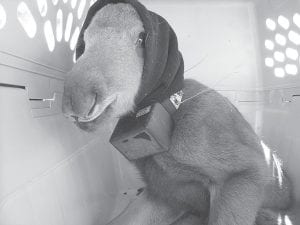The Minnesota DNR will purchase new GPS collars to be fitted on calves this spring after the ones purchased last year became too tight as the calves grew. When collars get too tight they fall off, but researchers want them to be on for the first year of a calf’s life so they can get needed data to help them explain why moose are dying off at such an alarming rate.

Minnesota’s first moose calf morbidity study ended earlier than planned when it was discovered that the GPS collars fitted on the calves were tighter than the researchers wanted them to be. Of the 49 calves collared last spring, only nine made it into winter, a mortality rate of 72 percent, which was far above the normal morbidity rate of 60 percent.
When questioned, Glenn D. DelGuidice, Minnesota Department of Natural Resources (DNR) research scientist/moose project leader, said, “As you may know, our last collared calf mortality occurred on November 26, 2013, the result of a secondary infection from wolf bites. During the necropsy we noted that the collar wasn’t expanding quite as much as it should, not tight, but we weren’t comfortable with it.
“On January 10, a GPS collar broke away from another calf, as designed, but early, so that calf became collar-free. Given this, we decided to remove the collars from the eight remaining calves during the adult captures in early February. The collar’s design has since been modified by the manufacturer to allow easier and greater expansion,” said DelGuidice.
The calf morbidity study dovetails with a larger ongoing study of GPS collared adult moose and is also related to several insect studies that will hopefully help the scientists put the pieces of the puzzle together so they can form a clear picture of what is causing the decline of moose in Minnesota.
The moose population has dropped from an estimated 8,840 in 2006 to an estimated 4,350 today. In the northwestern part of the state the population has fallen from more than 4,000 moose in the mid 1980s to less than 100 today. For years moose mortality was between 8 percent and 12 percent a year, but everything has changed and moose are dying at a much higher rate today.
With that, DelGuidice and his team will conduct another calf morbidity study this spring. And just because this year’s study ended early doesn’t mean a lot wasn’t accomplished, DelGuidice noted.
“We have learned some very useful things about calf survival and natural mortality forces impacting them. But it’s only been one year’s worth of data and it included a very severe winter. To gain the more thorough understanding of calf production, survival and specific causes of mortality relative to annually varying environmental conditions, and how they influence the dynamics of the moose population, several years are required. One year’s worth of data simply will not provide that level of understanding,” DelGuidice said.
This spring DelGuidice said his crew plan on, “capturing and GPScollaring about 35-40 calves.” But a change will be made in the way that the calves are caught and collared. Last year nine of the 49 captured calves died within days of being collared, and their deaths were attributed to the experience of being captured.
“This year we will conduct all captures from the ground—no use of a helicopter. Whereas helicopters seem to be essential in some parts of North American moose range to capture statistically valid sample sizes, after last year’s first experience in northeastern Minnesota, we believe that the helicopter was the primary disturbing factor, as careful and cautious as the very experienced capture crew tried to be. We don’t believe they did anything wrong; it may just be the nature of animal behavior for some relative to that kind of visible and audible disturbance. In several studies, which did not use helicopters, capture-related abandonment was very minimal. If we do have a few abandonments, we have an abandonment contingency plan developed to allow a few select zoos or facilities within the U.S. to accept these calves.”
Another thing being looked at was the early capture of the calves, which were collared within 36 hours of birth. The DNR will possibly extend the time to allow more bonding. But, said DelGuidice, “Our analysis showed no difference in bonding times between the seven dams that abandoned nine calves versus the 24 dams which did not abandon their 40 calves.”
Funding for this year’s project will come from the Minnesota DNR and beginning July 1, support will also come from an Environmental and Natural Resources Trust Fund Grant, said DelGuidice.
When asked how the moose both large and small were faring in this harsh winter, DelGuidice answered, “As far as how the calves or adult moose will survive the winter, it’s difficult to say. Of course, this has been a severe one with atypically deep snow cover. Snow cover tends to have much more of an impact on the survival of northern ungulates (hoofed animals) than cold temperatures. Close monitoring of the GPS-collared adults will provide some answers over the next month or so. We are planning a couple of fixed-wing flights within the next several weeks to see if we can determine the fate of the nine study calves,” DelGuidice said.


Loading Comments